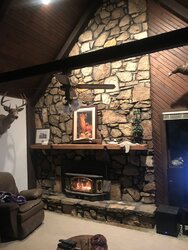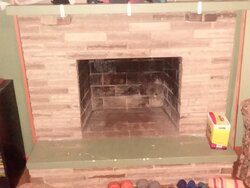I currently have a traditional fireplace in my basement that needs a liner in the chimney. I was considering putting in a wood burning insert or wood burning stove inside the fireplace. Can anyone provide pros and cons of the two? Has anyone done the same at their place?
Traditional Fireplace in Basement
- Thread starter AU Fan
- Start date
-
Active since 1995, Hearth.com is THE place on the internet for free information and advice about wood stoves, pellet stoves and other energy saving equipment.
We strive to provide opinions, articles, discussions and history related to Hearth Products and in a more general sense, energy issues.
We promote the EFFICIENT, RESPONSIBLE, CLEAN and SAFE use of all fuels, whether renewable or fossil.
You are using an out of date browser. It may not display this or other websites correctly.
You should upgrade or use an alternative browser.
You should upgrade or use an alternative browser.
Ashful
Minister of Fire
I currently have a traditional fireplace in my basement that needs a liner in the chimney. I was considering putting in a wood burning insert or wood burning stove inside the fireplace. Can anyone provide pros and cons of the two? Has anyone done the same at their place?
I grew up with a traditional fireplace in the basement of our house, and we used it frequently. More recently, I’ve owned five wood stoves, but never an insert. So, any advice I can provide is based on that experience, along with 7 years of reading others’ experiences with inserts, on this forum.
A free standing stove typically has the advantage over an insert, as it can radiate heat off all sides, and tends to move heat into the room better than an insert without a blower. In fact, some inserts require a blower to operate, although some can do reasonably well without one.
But, it may not be easy to fit a free-standing stove within most fireplaces. Also, if your fireplace is on an exterior wall, it’s likely that most of the heat radiated off the sides and back of the stove will be lost to masonry (heating the earth around the house). Inserts are generally designed to throw the majority of their heat off the front, to minimize this effect.
Some stoves are also designed (eg. Convective cast-clad steel stoves) to operate in this way, radiating very minimal heat off the back and sides. These are good candidates for installing inside a fireplace on an exterior wall.
These statements all sound very general, because they are. Better advice cannot be provided, without knowing more about the particulars of your situation.
I put an insert in my basement fireplace. The primary reason was so I could insulate behind the insert. We were taking in a lot of radiant cold through the stone. It does a great job even without the blower. I certainly wouldn’t spend the money to re-line the flue for an open Fireplace, I’d spend the money to upgrade to an insert or stove.
Attachments
Here is a photo of the existing fireplace. Trying to get ideas on stove or insert.
Dimensions are as follow:
Front height: 26"
Front width: 31 1/2"
Back width: 28 1/2"
Depth: 22 3/4
Hearth Depth: 12"
Hearth width 61"
Hearth to mantel: 40 1/4"
Floor in the room is concrete.
Dimensions are as follow:
Front height: 26"
Front width: 31 1/2"
Back width: 28 1/2"
Depth: 22 3/4
Hearth Depth: 12"
Hearth width 61"
Hearth to mantel: 40 1/4"
Floor in the room is concrete.
Attachments
Inserts will look better and be an easier fit/finish. Freestanders provide more heat as previously mentioned. Dimensions and pictures would help us steer you in the right direction.
I posted pictures and dimensions,
Ashful
Minister of Fire
Here is a photo of the existing fireplace. Trying to get ideas on stove or insert.
Dimensions are as follow:
Front height: 26"
Front width: 31 1/2"
Back width: 28 1/2"
Depth: 22 3/4
Hearth Depth: 12"
Hearth width 61"
Hearth to mantel: 40 1/4"
Floor in the room is concrete.
That’s an awful small fireplace to put a freestanding stove into. I have two fireplaces with freestanders in them, and even the smaller one (shown in my avatar) is 7x the volume of your fireplace. I’d be shopping inserts, if I were you.
edyit
Minister of Fire
Floor in the room is concrete.
this opens up a lot more possibilities for you if you're not against a rear venting stove connected to a cleanout T and insulated liner. you could slide the stove to the front of the hearth and not worry about front clearance, jotul and woodstock make rear vent stoves that i can think of off the top of my head, i'm sure others can suggest more if this is the way you decide to go.
AlbergSteve
Minister of Fire
Damn, that looks cozy!I put an insert in my basement fireplace. The primary reason was so I could insulate behind the insert. We were taking in a lot of radiant cold through the stone. It does a great job even without the blower. I certainly wouldn’t spend the money to re-line the flue for an open Fireplace, I’d spend the money to upgrade to an insert or stove.
Go with an insert for that low lintel. How large an area will it be heating? Is there an open stairwell nearby that will help warm air convect upstairs? Are the basement walls insulated?Here is a photo of the existing fireplace. Trying to get ideas on stove or insert.
Dimensions are as follow:
Front height: 26"
Front width: 31 1/2"
Back width: 28 1/2"
Depth: 22 3/4
Hearth Depth: 12"
Hearth width 61"
Hearth to mantel: 40 1/4"
Floor in the room is concrete.
yooper08
Minister of Fire
There are many with basement installs, me being one, so definitely not unheard of.
You're definitely going to be looking at the smaller inserts, ones like the Englander 13-NCI or the Drolet 1400i. Not sure about your space and heating goals, but that size may be just enough anyway if all you want to do is heat the basement.
You're definitely going to be looking at the smaller inserts, ones like the Englander 13-NCI or the Drolet 1400i. Not sure about your space and heating goals, but that size may be just enough anyway if all you want to do is heat the basement.
Yes, wall are insulated and there is a stairwell nearby.Go with an insert for that low lintel. How large an area will it be heating? Is there an open stairwell nearby that will help warm air convect upstairs? Are the basement walls insulated?
How large an area will the insert be heating? What is the budget?Yes, wall are insulated and there is a stairwell nearby.
How large an area will the insert be heating? What is the budget?
Budget around $3000-$4000. Would like to run full time to supplement an electric furnace.
About 2200 SQ FT.Budget around $3000-$4000. Would like to run full time to supplement an electric furnace.
Ashful
Minister of Fire
Figure stove at half of total project cost, if you’re doing a liner and other assorted items. So, $4k max budget = $2k max stove.
There are several decent value inserts in the $1,000-1,200 range, but all will be around 1.8-2.0 cu ft. For a large insert in the 2.4 to 3 cu range the choices are much more limited. Still, sometimes one can find a good deal in a floor model. Check on pricing for a Regency i3100. They are having a fall promo right now.
NewENGLANDER30
Member
I have a similar set up, fireplace in a finished lower and upstairs. I don't remember the dimension of the fireplace at the moment (working until 7am) but I installed the Englander Nc-30 in the fireplace downstairs.
It's a TIGHT fight (avatar pic). The masonry does soak up some heat, but also holds and releases back into the room. What's lost to the rear masonry and the world beyond is anyone's guess!
It makes maintenance of the stoves fan a bear of a task, but it made sense at the time. I still dont really have any regrets about the install. I did all the work myself. Those are some things to think about; down the line, maintenance of the fan, will you insulate and install a block off plate in the masonry chimney, difficulty of installing a liner.
Imagine trying to wrestle a 24ft steel slinky down your chimney from the roof
It's a TIGHT fight (avatar pic). The masonry does soak up some heat, but also holds and releases back into the room. What's lost to the rear masonry and the world beyond is anyone's guess!
It makes maintenance of the stoves fan a bear of a task, but it made sense at the time. I still dont really have any regrets about the install. I did all the work myself. Those are some things to think about; down the line, maintenance of the fan, will you insulate and install a block off plate in the masonry chimney, difficulty of installing a liner.
Imagine trying to wrestle a 24ft steel slinky down your chimney from the roof

Similar threads
- Replies
- 3
- Views
- 993
- Replies
- 2
- Views
- 609
- Replies
- 2
- Views
- 337
- Replies
- 3
- Views
- 908



